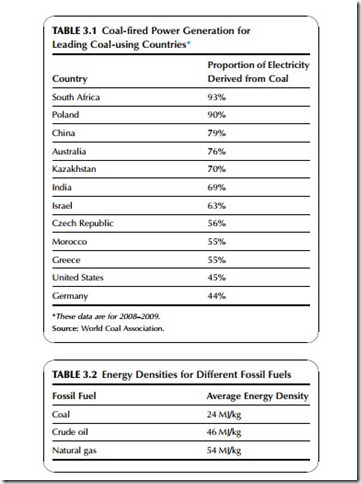Coal is the most important source of electrical power in the world today. At the end of the first decade of the 21st century it was responsible for over 40% of world electricity production, an annual output of around 8100 TWh out of a global total of 20,000 TWh in 2010, according to the U.S. Energy Information Administration.1
Significant deposits of coal can be found in most parts of the world, from the United States to South Africa, across Europe, many parts of Asia, and Australia. Exceptions exist, such as Japan and Taiwan, where resources are tiny; these countries, nevertheless, use large quantities of coal that they import. There are limited reserves in South America, and in Africa only South Africa has significant quantities while across the rest of that continent there is little.
The attractions of coal are that it is so widespread, it is often in plentiful sup- ply, and where it is available it provides both a cost-effective and a secure source of electricity. It is for these reasons that many of the major economies across the world, including the two largest—the United States and China—have built their economic prosperity on coal.
Figures from the World Coal Association suggest that 45% of U.S. electricity is generated in coal-fired power plants, while in China the proportion is 79%. Table 3.1 lists the proportion of power derived from the fuel for these and the 10 other nations that rely most heavily on coal for electricity. The most reliant is South Africa, which derives 93% of all its electricity from coal, followed closely by Poland with 90%. India is high up the list with 69%, while Germany, last on the list, derives 44% of its electrical power from coal. Many of these countries have their own reserves but some, such as Morocco, import the fuel.
Alongside availability, the cost of coal is another important factor in its dominance. Coal prices have traditionally been stable and low compared to alternative fossil fuels, with coal typically half the cost of natural gas on an energy content basis. In recent years the price of the fuel has shown greater volatility than in the past, as has the price of many other globally traded commodities. Nevertheless, the cost is still low enough to make it an attractive source of electricity in many parts of the world.
On the other hand, coal has a lower energy density than other fossil fuels (Table 3.2) and is consequently more expensive to transport. When it is trans- ported, it is usually by road over short distances; by rail, river, or canal over longer distances; and by ship when traded intercontinentally. Pipeline transportation, common with both oil and gas, cannot be used for coal. Therefore, coal is most economically utilized close to its source.
The major disadvantage of coal is that it is the dirtiest of the fossil fuels. Many coals contain significant amounts of sulfur, which when burned generates sulfur dioxide (SO2). They can also contain numerous trace elements including
heavy metals such as mercury, which are released when the fuel is burned and can find their way into the environment. Coal combustion, like all other types of fossil fuel combustion, generates nitrogen oxide (NOx), which is damaging if released into the atmosphere, and the combustion process also releases large quantities of dust. On top of this, coal combustion generates more carbon diox- ide (CO2) for each unit of energy produced than any other fossil fuel.
In spite of all these potential pollutants associated with its combustion, for most of its history as a source of electricity energy, coal combustion has not been controlled. As a consequence it has been one of the most widespread and damaging forms of human industrial activity, generating high levels of pollution in many parts of the world. Coal combustion is now much more tightly regulated than in the past, and extensive emission control systems are required for new coal-fired power stations built virtually anywhere. This has made coal- fired power generation less cost effective than in the past, but it still remains competitive with other major sources of electrical energy.
